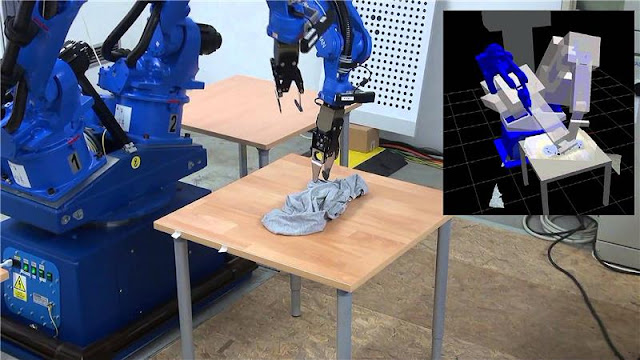The Daily Journalist.
The engineer in industrial robotics, Gerardo Aragon Camarasa, graduated from the School of Mechanical and Electrical Engineering (ESIME) of the Polytechnic Institute of Mexico (IPN). And now he is at the University of Glasgow in Scotland, as a post doctorate researcher who told us that technology is just starting and requires more work to be a final product. Although, he acknowledges that international companies have contacted them with interest to take over the prototype.
The robot has two standard robotic arms with six degrees of freedom, these are used on a daily basis in automated production lines in the car industry for welding and painting.
Aragon Camarasa explains that in the robot they designed both arms were mounted on a rotating base, which provides an extra degree of freedom for handling clothes, similar to the movement of the human waist. Regarding the sensors, the robot has a pair of grippers (tweezers) at each end to simulate a pair of fingers that can rub each other, providing the ability to perceive the texture of the material through touch.
At the University of Glasgow, the Mexican is working together with Li (Kevin) Sun and Dr. Paul Siebert, the last one opened the doors to him in this institution.
“I participated in the development of the project as a doctoral student under the tutelage of Paul. After two years of shaping the project proposal, it was accepted and months before completing the doctorate, Dr. Siebert offered me the job. ”
The project was sponsored by the European Union under the 7th Framework Programme for Research and Technological Development with a duration of three years.
Research to develop the prototype was completed in January. The robot has three Kinects that provide real-time 3D images and maps. These are located on the wrists and waist of the arms, serving for operation tasks.
Additionally, “the robot has an active head, which is the main contribution of the Glasgow project, which serves to capture high resolution and reconstruction of 3D maps, while the eyes move and focus the objects or points of interest in the clothes. The information processed by the head serves for accurate handling, and recognizing the type of material, to separate and define structures such as wrinkles and edges”.
The consortium members involved in the project are CERTH in Greece, CVUT in Prague, the universities of Genoa in Italy and Glasgow in Scotland, and Neovision, a company from the Czech Republic.
This company would be responsible for marketing the robot, though the intellectual property belongs to each university.
A little bit of history
Gerardo Aragon recalls that when he finished his studies at the ESIME, his thesis advisor, Dr. Emmanuel Merchan Cruz, suggested a doctoral study in the UK and his parents urged him to undertake postgraduate studies in another country.
Although he contacted several professors from various universities, only two wrote back telling him about their research and how he could fit in the working group.
Dr. Siebert offered various PhD projects and one of those was the robotic vision with an active head. After being accepted into college, he sought support from the National Council of Science and Technology (CONACYT) and the Alban program of the European Union offering support to Latin American students.
“The University of Glasgow, to date, has given me support as any other student and now as a member of the academic staff. Mexicans are highly regarded here, especially if you want to work and deliver a quality product. “(Agencia ID).



